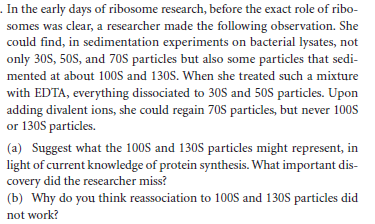. In the early days of ribosome research, before the exact role of ribo- somes was clear, a researcher made the following observation. She could find, in sedimentation experiments on bacterial lysates, not only 30S, 50S, and 70S particles but also some particles that sedi- mented at about 100S and 130S. When she treated such a mixture with EDTA, everything dissociated to 30S and 50S particles. Upon adding divalent ions, she could regain 70S particles, but never 100S or 130S particles. (a) Suggest what the 100S and 130S particles might represent, in light of current knowledge of protein synthesis. What important dis- covery did the researcher miss? (b) Why do you think reassociation to 100S and 130S particles did not work?
. In the early days of ribosome research, before the exact role of ribo- somes was clear, a researcher made the following observation. She could find, in sedimentation experiments on bacterial lysates, not only 30S, 50S, and 70S particles but also some particles that sedi- mented at about 100S and 130S. When she treated such a mixture with EDTA, everything dissociated to 30S and 50S particles. Upon adding divalent ions, she could regain 70S particles, but never 100S or 130S particles. (a) Suggest what the 100S and 130S particles might represent, in light of current knowledge of protein synthesis. What important dis- covery did the researcher miss? (b) Why do you think reassociation to 100S and 130S particles did not work?
Biology: The Dynamic Science (MindTap Course List)
4th Edition
ISBN:9781305389892
Author:Peter J. Russell, Paul E. Hertz, Beverly McMillan
Publisher:Peter J. Russell, Paul E. Hertz, Beverly McMillan
Chapter4: Cells
Section: Chapter Questions
Problem 7TYK: Which of the following statements about proteins is correct? a. Proteins are transported to the...
Related questions
Question

Transcribed Image Text:. In the early days of ribosome research, before the exact role of ribo-
somes was clear, a researcher made the following observation. She
could find, in sedimentation experiments on bacterial lysates, not
only 30S, 50S, and 70S particles but also some particles that sedi-
mented at about 100S and 130S. When she treated such a mixture
with EDTA, everything dissociated to 30S and 50S particles. Upon
adding divalent ions, she could regain 70S particles, but never 100S
or 130S particles.
(a) Suggest what the 100S and 130S particles might represent, in
light of current knowledge of protein synthesis. What important dis-
covery did the researcher miss?
(b) Why do you think reassociation to 100S and 130S particles did
not work?
Expert Solution
This question has been solved!
Explore an expertly crafted, step-by-step solution for a thorough understanding of key concepts.
This is a popular solution!
Trending now
This is a popular solution!
Step by step
Solved in 2 steps

Recommended textbooks for you

Biology: The Dynamic Science (MindTap Course List)
Biology
ISBN:
9781305389892
Author:
Peter J. Russell, Paul E. Hertz, Beverly McMillan
Publisher:
Cengage Learning

Biology 2e
Biology
ISBN:
9781947172517
Author:
Matthew Douglas, Jung Choi, Mary Ann Clark
Publisher:
OpenStax

Biochemistry
Biochemistry
ISBN:
9781305577206
Author:
Reginald H. Garrett, Charles M. Grisham
Publisher:
Cengage Learning

Biology: The Dynamic Science (MindTap Course List)
Biology
ISBN:
9781305389892
Author:
Peter J. Russell, Paul E. Hertz, Beverly McMillan
Publisher:
Cengage Learning

Biology 2e
Biology
ISBN:
9781947172517
Author:
Matthew Douglas, Jung Choi, Mary Ann Clark
Publisher:
OpenStax

Biochemistry
Biochemistry
ISBN:
9781305577206
Author:
Reginald H. Garrett, Charles M. Grisham
Publisher:
Cengage Learning

Anatomy & Physiology
Biology
ISBN:
9781938168130
Author:
Kelly A. Young, James A. Wise, Peter DeSaix, Dean H. Kruse, Brandon Poe, Eddie Johnson, Jody E. Johnson, Oksana Korol, J. Gordon Betts, Mark Womble
Publisher:
OpenStax College